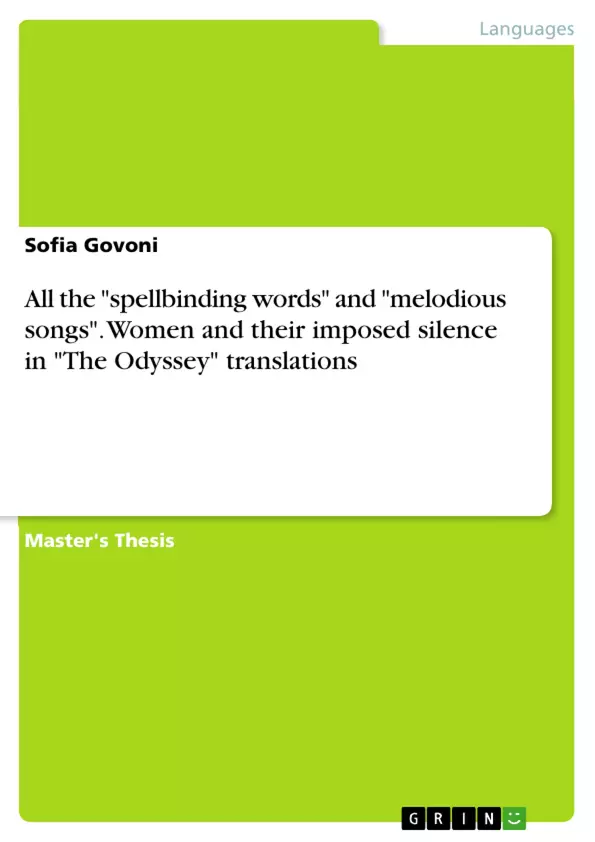The main topic of this work is the imposed silence on women in translation, an activity that had always been the only intellectual activity that was considered suitable for them.
The first chapter wanted to define the concept of "translation" in all its facets and all historical and cultural tendencies. Particularly, it was observed that translation was suitable for women because of its intellectual inferiority, and because of this was the only academical activity suitable for them. But, in the course of history, it became just another tool at the service of the dominant part in society, the male part, that used it only to oppress women. To affirm this all the attempts made by women to break the silence imposed to them were considered, starting form the history of the feminist movement and all other ideologies that contributed to create and support the stereotypes imposed on women.
The second chapter analyses the first English translation of the Odyssey by the Greek poet Homer made by a woman, Professor Emily Wilson. In fact, all the available English translations of this text were made by men, that succeded in reducing women to silence. This was an innovative text, and to demonstrate this, the relevant passages featuring the female protagonists of the book were compared with the version by Peter Green, in the attempt to find the main differences, not only stylistic, but also the ones given by the different gender of the translator. Also, it was possible to find the sexism that had already been present in the book, but was reinforced in all translations. Key tool for this analysis was Skopos Theory, that puts in the first place the functionality of translation and, most of all, considers the importance of the cultural aspect in the definition of every translated text.
Inhaltsverzeichnis (Table of Contents)
- INTRODUCTION
- CHAPTER ONE
- 1.1 What does it mean "to translate"?
- 1.2 An attempt to define this term
- 1.3 Culture: what lies beneath translation
- 1.4 Is it ideology the cause of women's oppression?
- 1.5 Authoship is for men, translation ONLY is for women
- 1.6 On language and masculinity
- 1.7 Women as authors (or translators): was it even seen as a taboo?
- 1.8 The first acts of rebellion from all ideologies
- 1.9 Translation as an attempt of oppression?
- 1.10 Les belles infidèles: women stereotypes in translation
- CHAPTER TWO
- 2.1 Skopos Theory or functional translation?
- 2.2 Translation and equivalence
- 2.3 Decision-making in translation
- 2.4 Emily Wilson's translation of The Odyssey: is the glass ceiling finally broken?
- 2.5 A man invading “the woman's place” again: Peter Green's translation
- 2.6 Odysseus: has the god turned into a normal man?
- 2.7 Calypso and Circe: the “fair-tressed” nymphs that deceive men
- 2.8 Nausicaa and Penelope: an example of feminine devotion and fidelity
- 2.9 The female slaves: an attempt to eradicate sexism
- CONCLUSIONS
Zielsetzung und Themenschwerpunkte (Objectives and Key Themes)
This study aims to explore the historical and contemporary significance of women's roles in translation, particularly in the context of The Odyssey. It seeks to understand the underlying social and cultural dynamics that have shaped these roles, examining the connections between translation, gender, and power dynamics.
- The evolution of translation as a profession and its relationship with gender.
- The impact of societal ideologies on women's participation in translation.
- The portrayal of women in literary works and how translation influences their representation.
- The power dynamics inherent in the act of translation and its potential for challenging societal norms.
- The intersection of translation studies, gender studies, and literary analysis in interpreting and understanding the role of women in The Odyssey.
Zusammenfassung der Kapitel (Chapter Summaries)
Chapter One delves into the multifaceted nature of translation, exploring its historical and cultural significance. It examines the concept of "cultural translation" and how it shapes our understanding of different societies and perspectives. The chapter also explores the impact of ideology on women's roles in translation, analyzing how societal norms have traditionally limited women's opportunities in literary and intellectual pursuits. It examines how women's contributions to translation have often been overlooked and undervalued, highlighting the need for a more nuanced and equitable understanding of their historical contributions.
Chapter Two focuses on the application of Skopos Theory and functional translation to the study of The Odyssey translations. It examines the concept of "equivalence" in translation and how different translators approach the task of conveying the source text's meaning and style. The chapter delves into the specific translation choices made by Emily Wilson and Peter Green, analyzing how their interpretations reflect their perspectives on gender and power dynamics within the epic poem. It also examines the representation of female characters like Calypso, Circe, Nausicaa, and Penelope, exploring how their roles and motivations have been portrayed and interpreted by different translators.
Schlüsselwörter (Keywords)
The main keywords and focus topics of the text include: translation studies, gender studies, literary analysis, The Odyssey, women translators, societal ideologies, cultural translation, equivalence, power dynamics, feminine representation, and interpretation of literary works.
- Citar trabajo
- Sofia Govoni (Autor), 2018, All the "spellbinding words" and "melodious songs". Women and their imposed silence in "The Odyssey" translations, Múnich, GRIN Verlag, https://www.grin.com/document/471235



